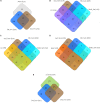Establishment of Coral-Bacteria Symbioses Reveal Changes in the Core Bacterial Community With Host Ontogeny
- PMID: 31338082
- PMCID: PMC6629827
- DOI: 10.3389/fmicb.2019.01529
Establishment of Coral-Bacteria Symbioses Reveal Changes in the Core Bacterial Community With Host Ontogeny
Abstract
Bacterial communities are fundamental symbionts of corals. However, the process by which bacterial communities are acquired across the life history of corals, particularly in larval and early juvenile stages, is still poorly characterized. Here, transfer of bacteria of the Scleractinian coral Acropora digitifera from adults to spawned egg-sperm bundles was analyzed, as well as acquisition across early developmental stages (larvae and newly settled spat), and 6-month-old juveniles. Larvae were reared under manipulated environmental conditions to determine the source (maternal, seawater, or sediment) of bacteria likely to establish symbiotic relationships with the host using amplicon sequencing of the 16S rRNA gene. Maternal colonies directly transferred bacteria from the families Rhodobacteraceae, Cryomorphaceae, and Endozoicimonaceae to egg-sperm bundles. Furthermore, significant differences in the microbial community structure were identified across generations, yet the structure of the coral bacterial community across early life history stages was not impacted by different environmental rearing conditions. These data indicate that the uptake and structure of bacterial communities is developmentally, rather than environmentally, regulated. Both maternal coral colonies and ubiquitous bacteria found across environmental substrates represent a potential source of symbionts important in establishing the coral microbiome. Uniquely, we report the presence of variation with ontogeny of both the core and resident bacterial communities, supporting the hypothesis that microbial communities are likely to play specific roles within the distinct life history stages of the coral host.
Keywords: 16S rRNA; bacterial communities; core bacterial communities; metabarcoding; seawater; sediment; symbiosis; transmission.
Figures







Similar articles
-
Onset and establishment of diazotrophs and other bacterial associates in the early life history stages of the coral Acropora millepora.Mol Ecol. 2014 Oct;23(19):4682-95. doi: 10.1111/mec.12899. Mol Ecol. 2014. PMID: 25156176
-
Early Life Stages of a Common Broadcast Spawning Coral Associate with Specific Bacterial Communities Despite Lack of Internalized Bacteria.Microb Ecol. 2020 Apr;79(3):706-719. doi: 10.1007/s00248-019-01428-1. Epub 2019 Aug 21. Microb Ecol. 2020. PMID: 31435691
-
Seasonal fluctuations in symbiotic bacteria and their role in environmental adaptation of the scleractinian coral Acropora pruinosa in high-latitude coral reef area of the South China Sea.Sci Total Environ. 2021 Oct 20;792:148438. doi: 10.1016/j.scitotenv.2021.148438. Epub 2021 Jun 11. Sci Total Environ. 2021. PMID: 34153755
-
The Microbial Signature Provides Insight into the Mechanistic Basis of Coral Success across Reef Habitats.mBio. 2016 Jul 26;7(4):e00560-16. doi: 10.1128/mBio.00560-16. mBio. 2016. PMID: 27460792 Free PMC article.
-
Defining the Core Microbiome in Corals' Microbial Soup.Trends Microbiol. 2017 Feb;25(2):125-140. doi: 10.1016/j.tim.2016.11.003. Epub 2016 Dec 3. Trends Microbiol. 2017. PMID: 27919551 Review.
Cited by
-
Identification of quorum sensing-regulated Vibrio fortis as potential pathogenic bacteria for coral bleaching and the effects on the microbial shift.Front Microbiol. 2023 Feb 3;14:1116737. doi: 10.3389/fmicb.2023.1116737. eCollection 2023. Front Microbiol. 2023. PMID: 36819038 Free PMC article.
-
Microbiome of the Southwestern Atlantic invasive scleractinian coral, Tubastraea tagusensis.Anim Microbiome. 2020 Aug 11;2(1):29. doi: 10.1186/s42523-020-00047-3. Anim Microbiome. 2020. PMID: 33499978 Free PMC article.
-
Reconstitution and Transmission of Gut Microbiomes and Their Genes between Generations.Microorganisms. 2021 Dec 30;10(1):70. doi: 10.3390/microorganisms10010070. Microorganisms. 2021. PMID: 35056519 Free PMC article. Review.
-
The source of microbial transmission influences niche colonization and microbiome development.Proc Biol Sci. 2024 Feb 14;291(2016):20232036. doi: 10.1098/rspb.2023.2036. Epub 2024 Feb 7. Proc Biol Sci. 2024. PMID: 38320611 Free PMC article.
-
A gauge of coral physiology: re-examining temporal changes in Endozoicomonas abundance correlated with natural coral bleaching.ISME Commun. 2024 Jan 12;4(1):ycae001. doi: 10.1093/ismeco/ycae001. eCollection 2024 Jan. ISME Commun. 2024. PMID: 38371393 Free PMC article.
References
-
- Aeby E. R., Richards Z. T., Delbeek J. T., Reboton C., Bass D. (2014). Acropora digitifera. IUCN Red List Threat. Species 2014:e.T133250A54223617.
LinkOut - more resources
Full Text Sources

